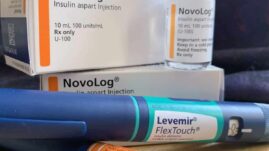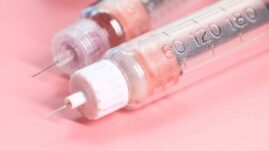If you live with insulin-dependent diabetes, whether it’s type 1, type 2, MODY, LADA, or gestational, you know that the condition requires the administration of exogenous insulin for survival.
But what does insulin actually do? How come there’s no insulin pill? Why can’t you drink it? What’s the mechanism of action, and how does it all work?
This article will explain what insulin does when we take those injections day in and day out.

What is insulin?
Insulin is a hormone produced by the beta cells in the pancreas. It is necessary for your body to turn food into energy and controls your blood sugar levels.
All humans have insulin in their bodies, but people with diabetes either do not make insulin, do not produce enough of it, or cannot use it properly (insulin resistance).
Insulin is considered to be the main anabolic hormone of the body, and its primary function is to facilitate the absorption of glucose from the bloodstream into the cells of the body (muscular and fat), as well as the liver.
When there is no insulin production (or there’s not enough insulin) in the body, a diagnosis of diabetes mellitus is made.
Why do we need insulin?
Insulin is needed to carry glucose from the bloodstream into the cells, fueling them with energy (and in excess, it is stored as fat). This energy is necessary for the body and brain to function.
Glucose mainly comes from foods rich in carbohydrates, like bread, potatoes, and fruit, but when you are short on carbohydrates, glucose can also be created from fat and protein in a process called gluconeogenesis.
When humans do not have insulin, cells cannot metabolize glucose, and it stays in the bloodstream, resulting in high blood sugar levels.
This is tested by an over-the-counter glucometer, or an HbA1c test which measures average blood glucose over the previous 3 months. You can do this yourself with a home HbA1c test.
Uncontrolled high blood sugars can quickly lead to diabetic ketoacidosis (DKA), a dangerous condition where the glucose levels are so high in the bloodstream that the body’s blood becomes acidic; it can become fatal if not properly (and quickly!) treated.
When the cells are starved of glucose, typical symptoms of diabetes and/or DKA set in, such as:
- Weight loss
- Extreme thirst
- Extreme hunger
- Frequent urination
- Blurry vision
- Fruity smelling breath
- Extreme fatigue
- Bodyache
- Loss of consciousness/death
If you’ve been experiencing these symptoms for a few days with no relief, seek emergency medical attention or call 911, as these may be early symptoms of diabetes, which will require immediate and professional healthcare.
What does insulin do?
The beta cells of the pancreas can sense when blood sugar levels are rising or dropping, and release insulin into the bloodstream accordingly.
If someone eats an apple, but the beta cells sense that the person’s blood sugar is low, they won’t release as much insulin as they would if they sense someone’s blood sugar is higher and they eat that same apple.
These micro titrations occur every second of every day without most humans even realizing that their bodies are performing these functions!
In people with diabetes, however, this whole process needs to happen externally: people need to count carbohydrates, constantly be checking their blood sugar levels, and measure and dose insulin accordingly.
Once insulin moves from the bloodstream into the cells, one’s blood sugar levels (the amount of glucose in the bloodstream) will go back down to normal.
However, for people with diabetes, if they take too much insulin, they risk going into hypoglycemia or low blood sugar.
Taking insulin if you have diabetes is pretty much a constant tightrope walk between avoiding hyperglycemia (high blood sugar) and hypoglycemia.
In people without diabetes, a normal fasting blood sugar is below 99 mg/dL. If you have diabetes, your ideal blood sugars will depend on your lifestyle, age, activity level, stage of life, and health goals, and will be determined by you and your doctor.
How often do people with diabetes take insulin?
People with insulin-dependent diabetes need insulin in their bodies 24/7 and take it daily.
Unlike most oral medications that can be taken once per day, people with insulin-dependent diabetes must take insulin for most of the food they eat and beverages they drink, unless those foods and drinks have zero carbohydrates.
They take what is called rapid-acting insulin (bolus insulin) for most meals. Rapid-acting insulin stays in the bloodstream for usually between 2-5 hours (depending on the brand and the body’s response to it).
People with diabetes who are on insulin pumps rely solely on rapid-acting insulin where the insulin pump releases a very small amount of insulin in constant increments 24/7, mimicking a human pancreas.
You can learn more about insulin for pumps here: Insulin for Pumps: What Are the Options?
If someone with diabetes does not want to or can’t wear an insulin pump, they may opt for multiple daily injections (MDI). This is where they take both long-acting and rapid-acting insulin.
Long-acting insulin (basal insulin) is usually administered once or twice per day (this type of insulin stays in the bloodstream for much longer and is metabolized a little bit at a time), along with rapid-acting insulin for meals and carbohydrates consumed.
Long-acting insulin is required (if someone is not on an insulin pump) because not only food raises blood sugar levels. Insulin is a necessary hormone for life, and even if you eat nothing for a day, you still require a minimal amount of insulin to live.
Side effects of insulin
The main side effect of insulin is also the most well-known: low blood sugar! The signs that you’ve taken too much insulin and are suffering from a low blood sugar include:
- Shakiness
- Confusion
- Sweating
- Rapid heartbeat
- Pale skin
- Loss of consciousness
- In extreme cases, seizures
Rarely, someone may experience redness, swelling, or burning at an injection site, which may be a sign of an allergic reaction.
More severe allergic reactions may include nausea or vomiting, and you should contact your doctor immediately if you’re experiencing that when you take insulin.
You can learn more about insulin side effects in our guide Insulin Side Effects: What You Need to Know.
Summary
If you live with insulin-dependent diabetes, you will require exogenously administered (usually injected) insulin to live. This helps maintain blood glucose levels and prevents them from reaching dangerously high levels.
Insulin is a hormone produced by the beta cells in the pancreas and helps facilitate the movement of glucose from the bloodstream into the cells of the body, including muscle and fat cells, along with the liver.
In people without diabetes, the beta cells sense blood sugar levels and automatically release a constant amount of insulin into the bloodstream to help maintain homeostasis of blood sugar levels.
In people with diabetes, the counting of carbohydrates eaten, testing of blood sugar levels, and measuring and administering of insulin must be done manually daily to prevent illness and death and to maintain healthy blood sugar levels.
Keeping your blood sugar levels in a good range can help prevent the onset of diabetes complications.
In addition to insulin, people with diabetes should manage their diet and exercise regularly to help maintain blood glucose levels.
Always talk with your doctor to find the most effective combination of prescription medications, lifestyle changes, and insulin therapy to meet your health goals.




Mike Gross
Medical jargon goes right over my head. I previously had no interest in learning/understanding anything medical. It was 1 1/2 yrs ago at 63yrs old, 155lbs, when I was 1st diagnosed type 2, I recieved very little explanation and for weeks had anxiety about the unknown. Then I was informed I had type 1, again with very little explanation. Then I was informed I have LADA. The Diabetes Strong site with articles such as this one, “Insuline explained: How does it work” have been a blessing to help me gain understanding and reassurance that I can manage my diabetes. My A1C has gone from 9.2 to 6.2 over this past year. I credit that to diet, exercise and the information I have read from the Diabetes Strong newsletters/web site. This old man… thanks you!
Christel Oerum, MS
I’m so happy to hear that. Thank you for the kind feedback and congrats on achieving an A1c of 6.2!